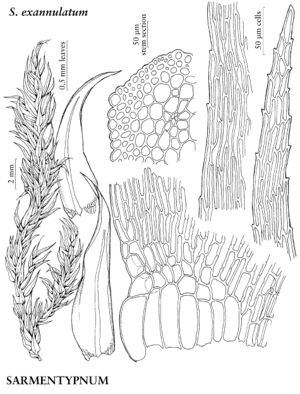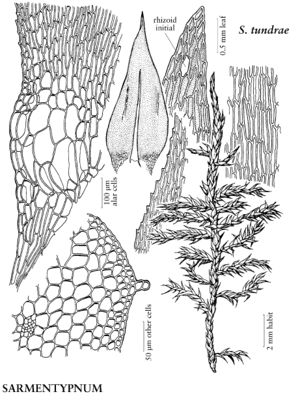Sarmentypnum
Ann. Bot. Fenn. 16: 223. 1979.
| Taxon | Illustrator ⠉ | |
|---|---|---|
 | Sarmentypnum exannulatum | Patricia M. Eckel |
 | Sarmentypnum pseudosarmentosum | Patricia M. Eckel |
 | Sarmentypnum tundrae | Patricia M. Eckel |
Plants medium-sized to large, green, yellow-green, brownish, redbrown, or with clear red pigment. Stems sparsely to densely radially branched; hyalodermis absent or sometimes partial, central strand present; outer pseudoparaphyllia broad, triangular to broader than long and often irregular; rhizoids or rhizoid initials at various points on leaves, or on scattered points or in rows on stem; axillary hairs not well developed, usually few, distal cells 1–7, hyaline or brown when young. Stem-leaves triangular to ovate or narrowly ovate, gradually or abruptly narrowed to apex, straight or falcate, concave or strongly concave, not or indistinctly plicate; base not or hardly decurrent (broadly long-decurrent in S. tundrae); margins entire or denticulate; apex acuminate, obtuse, or broadly rounded and usually apiculate; costa single, 3/5 leaf length to long-excurrent; alar cells differentiated, many, quadrate or short to long-rectangular, inflated or strongly inflated, hyaline, walls thin, or, especially near costa or when old, red or brown and incrassate, region distinctly delimited, large, transversely triangular, from margins ± to costa; medial laminal cell-walls incrassate or thin, porose or not. Sexual condition dioicous; inner perichaetial leaves not plicate; vaginula naked. Capsule with annulus not separating; exostome external surface reticulate proximally, margins dentate distally. Spores 11–24 µm.
Distribution
Nearly worldwide
Discussion
Species 7 (5 in the flora).
The leaves of Sarmentypnum are either moderately curved to straight and gradually narrowed to the apex, or straight and suddenly narrowed to a usually apiculate apex. Red pigments are frequent in several species, and the leaves are nondecurrent in all except S. tundrae. The alar regions are transversely triangular and consist of inflated and (at least when young) usually hyaline cells. Except for S. tundrae, species of Sarmentypnum occur in intermediately mineral-rich fens and nutrient-poor habitats. Sarmentypnum collections with falcate leaves and lacking sporophytes or red pigment are frequently confused with falcate-leaved species with transversely triangular alar regions in the Drepanocladus aduncus complex. The frequently present rhizoid initials occurring close to leaf apices in all species of Sarmentypnum except S. trichophyllum differentiate these from species of Drepanocladus, which lack such initials.
Selected References
None.
Lower Taxa
Key
| 1 | Stem leaf bases broadly long-decurrent; plants never red. | Sarmentypnum tundrae |
| 1 | Stem leaf bases not or hardly decurrent; plants often with red secondary pigment | > 2 |
| 2 | Leaf costae excurrent; branch and often shoot apices pencil-like; axillary hair distal cells 2-7, brown when young. | Sarmentypnum trichophyllum |
| 2 | Leaf costae not excurrent; branch and shoot apices not pencil-like; axillary hair distal cells 1-4(-5), hyaline when young | > 3 |
| 3 | Stem leaves oblong, ovate, or narrowly ovate, ± abruptly narrowed to apex; apices rounded- or acute-apiculate. | Sarmentypnum sarmentosum |
| 3 | Stem leaves ovate or ovate-triangular, gradually narrowed to apex; apices acuminate or sometimes blunt | > 4 |
| 4 | Stem leaves falcate or straight; margins distinctly denticulate proximally, distally, or both; marginal cells at widest part of leaf often differentiated from medial cells; leaves concave; apices sometimes furrowed but not strongly so. | Sarmentypnum exannulatum |
| 4 | Stem leaves straight or almost so; margins entire or in part finely, obtusely denticulate; marginal cells at widest part of leaf similar to medial cells or rarely slightly differentiated; leaves strongly concave; apices deeply furrowed. | Sarmentypnum pseudosarmentosum |
"long-excurrent" is not a number.